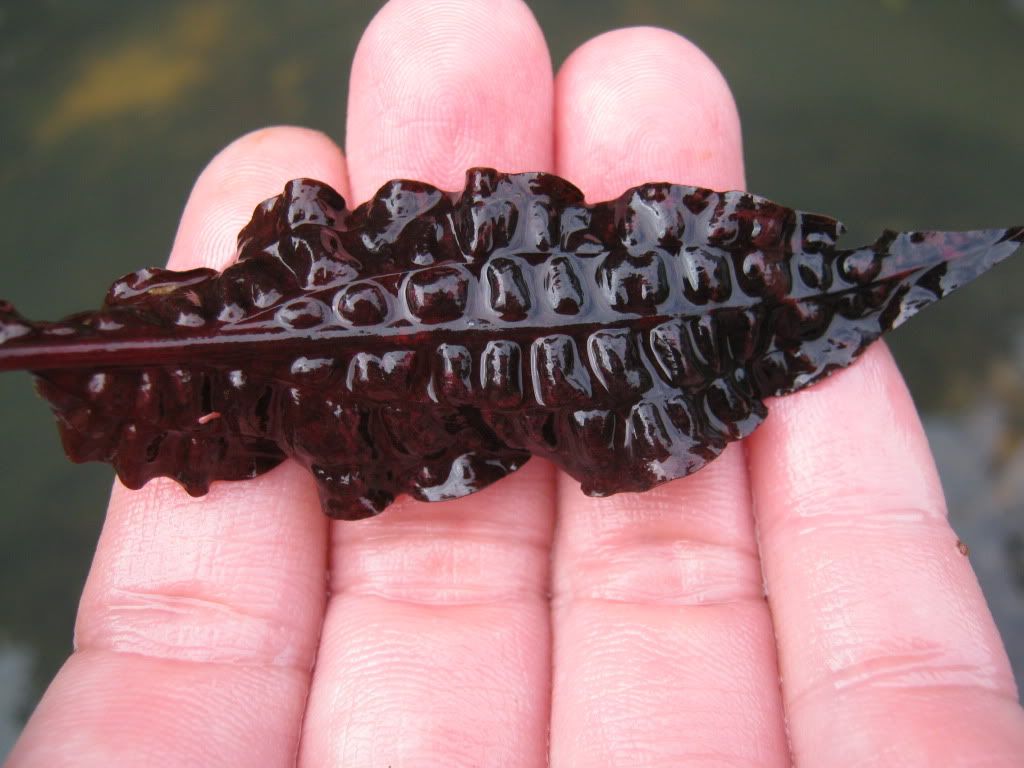At many of the habitats of C. affinis, snails such as the ones shown below can be found living in the water among the cryptocorynes. My explorer friend told me that these snails often end up as food for the larva of fireflies.
Can you spot the similarities?!?!?!? Hahahaha. How did the genes of the snails get transferred into the cryptocorynes???
Monday, February 21, 2011
Sunday, February 13, 2011
C. pontederiifolia 'Thomson' - a master of adaptability
I was checking on the good works carried out by my platys, guppies and bettas in helping me to clean up my pots of infested cryptocorynes (i.e. infested with algae, mould, fungus, aphids, etc) when i suddenly realised ......
...... that my C. pontederiifolia 'Thomson' was flowering. This was one of my very first specimen in my collection. It was so stable that I decided not to keep it in my cultivation tanks when I did not have sufficient space and threw it into my metal tub in my balcony.
...... that my C. pontederiifolia 'Thomson' was flowering. This was one of my very first specimen in my collection. It was so stable that I decided not to keep it in my cultivation tanks when I did not have sufficient space and threw it into my metal tub in my balcony.
The plants were adapting well. Even though the pot was already toppled over long time ago, the roots of the plants were growing well and forming a thick web over the pot holding the soil in place.
I hope that these plants will continue to grow well, feeding off the nutrients from the mulm of the fishes.
C. sp. 'Pahang 1' revisited (mini C. affinis?)
I revisited the habitat of C. sp. 'Pahang 1' at the northern part of Pahang. The water in the large river is at almost the same level as when I first visited it more than 2 years ago. Both emersed and submersed specimens could be found growing along the banks of the river. No spathes could be found at all again. The cryptocorynes were growing among the fine roots of the trees along the banks making them very difficult to collect. The pH was surprisingly rather high at about 9.0.
Could these be miniature C. affinis judging from the looks of the leaves as well as the location the were found? They have great potential to be good foreground plants for planted tanks!
Thursday, February 10, 2011
C. sp. 'Sedili 6' bloomed!!!!
A fellow master cryptocoryne cultivator in Japan managed to bloom C. sp. 'Sedili 6' and my explorer friend managed to obtain some photographs from him and posted them in his blog: see this posting!!!. From the appearance of the leaves, my explorer friend guessed previously that it could be comparable to C. decus silvae.
From the latest development with the verification of a blooming spathe, I thought that C. sp. 'Sedili 6' could be possibly comparable too to C. sp. 'Kota Tinggi' (which is good news since the currently only known habitat of C. sp. 'Kota Tinggi' had been destroyed already) or even C. jacobsenii??? What do you think?
From the latest development with the verification of a blooming spathe, I thought that C. sp. 'Sedili 6' could be possibly comparable too to C. sp. 'Kota Tinggi' (which is good news since the currently only known habitat of C. sp. 'Kota Tinggi' had been destroyed already) or even C. jacobsenii??? What do you think?
Labels:
C. jacobsenii,
C. sp. 'Kota Tinggi',
C. sp. 'Sedili'
C. sp. 'Pahang 8' = C. cf. xpurpurea 'Rompin'? - a difference in perception and attitute resulted in difference in outcome
I visited an old cryptocoryne habitat we found in 2009 at Rompin area within Pahang State with my explorer friend and found another batch of cryptocorynes growing about 100m away from where we found the previous batch of cryptocorynes. The habitat was a flooded forest with sandy bed.
The close up photographs of the leaves are as follow.
The close up photographs of the leaves are as follow.
As usual, barclaya motleyi could be found growing abundantly together with the cryptocorynes.
We found many spathes but none had bloomed yet then.This is where a difference in perception and attitude resulted in a difference in outcome eventually. For me, I will always assume that any specimens found near a repeated habitat are the same as what we found previously although the leaves may look slightly different. Therefore I did not collect any specimens back.
My explorer friend will always assume otherwise. He will assume that the specimens are different from what we previously found near a repeated habitat if there are differences in the appearance of the leaves. He collected some specimens back.
A few days later he called me to inform me that the spathe bloomed and the specimens turned out to be a different species compared to what we collected previously from the same location. Below are the photographs of the spathe for your reference.
My explorer friend felt that it could be comparable to one of the C. cordata group variety. I thought that the spots on the limb could be comparable to C. xpurpurea but the female portion of the flower (i.e. stigma) seemed to be longer than that of a typical C. xpurpurea and it did not have the typical wide collar area as well..... So what do you think??? I shall term it as C. sp. 'Pahang 8' first.
Sunday, February 6, 2011
C. affinis 'West Pahang - Metallic Red'
West Pahang area was really a kingdom for C. affinis. During our recent trip there, we found quite a few different locations with C. affinis. I will try to follow how my explorer friend named the C. affinis found at the various locations based on their local variation characteristics so as not to create further confusions.
Pahang was rather far from Singapore and we spent a day travelling up to Pahang and staying over for 1 night before commencing our pre "Chinese New Year house visiting" to the various cryptocoryne habitats. After visiting a fresh water lake with "sea-side" banks and a flooded swamp forest, we stayed over at a town flooded with swallows and had dinner and breakfast at the local Chinese coffee shops there.
The first location my friend brought me to visit was the habitat of what he termed as C. affinis 'metallic red' based on the colour of the leaves of the specimens found there. It was a river flowing out of a forest with rather fast flowing water. Carpets of C. affinis could be found in this river.
The river had fine sandy base and a neutral pH.
One thing I always liked about visiting habitats with submersed specimens with bullate leaves was the view of how the pockets of undulations on the leaves retained the fine sand particles washed across the leaves by the water.
Specimens with leaves of various degree of redness could be found here.
My photographs above do not bring justice to why my friend termed these specimens as "metallic red" and therefore I imported a photograph taken by my friend and posted on his blog for your reference below.
We found many fully blooming spathes here, sticking out of the water for various reasons...

Pahang was rather far from Singapore and we spent a day travelling up to Pahang and staying over for 1 night before commencing our pre "Chinese New Year house visiting" to the various cryptocoryne habitats. After visiting a fresh water lake with "sea-side" banks and a flooded swamp forest, we stayed over at a town flooded with swallows and had dinner and breakfast at the local Chinese coffee shops there.
The first location my friend brought me to visit was the habitat of what he termed as C. affinis 'metallic red' based on the colour of the leaves of the specimens found there. It was a river flowing out of a forest with rather fast flowing water. Carpets of C. affinis could be found in this river.
The river had fine sandy base and a neutral pH.
One thing I always liked about visiting habitats with submersed specimens with bullate leaves was the view of how the pockets of undulations on the leaves retained the fine sand particles washed across the leaves by the water.
Specimens with leaves of various degree of redness could be found here.
My photographs above do not bring justice to why my friend termed these specimens as "metallic red" and therefore I imported a photograph taken by my friend and posted on his blog for your reference below.
We found many fully blooming spathes here, sticking out of the water for various reasons...

As usual, we cut open the kettle of one of the spathe to capture the photographs of the male and female portion of the flower therein for you reference too.
Other C. affinis found at other habitats around west Pahang will be featured in separate postings.
Subscribe to:
Comments (Atom)
























































